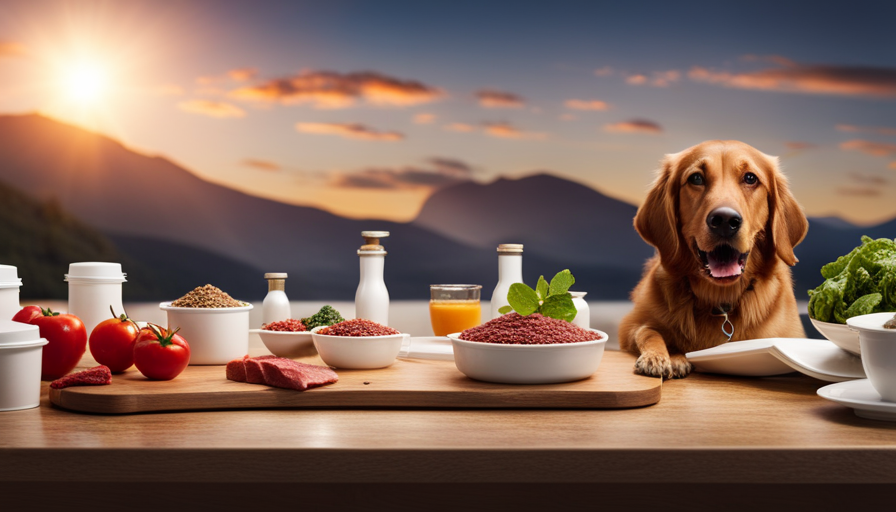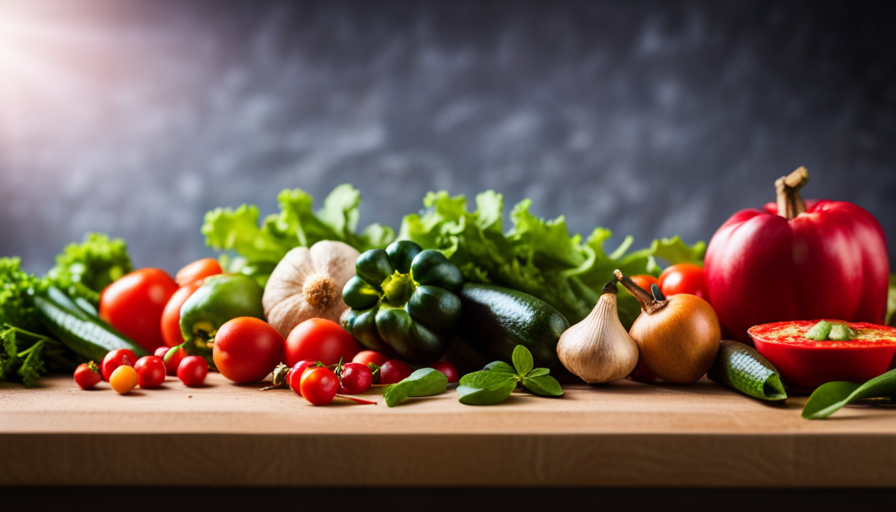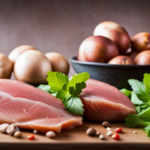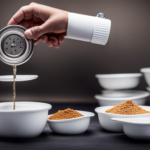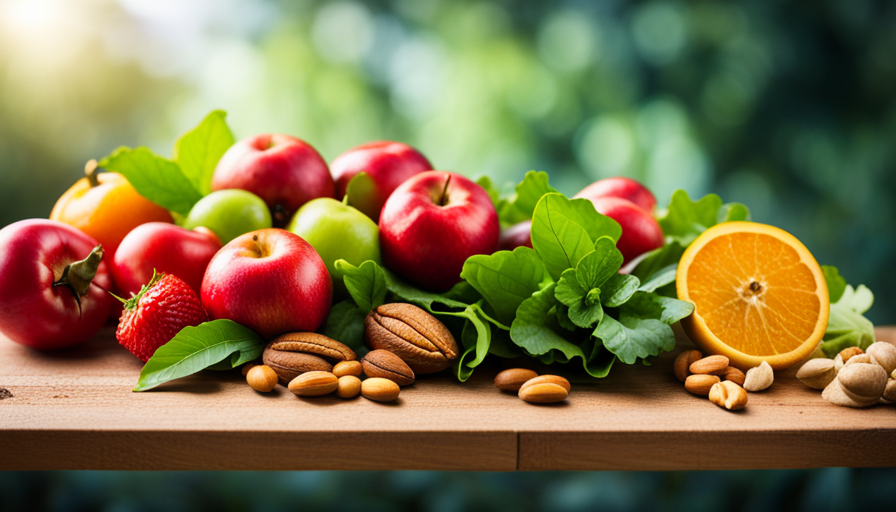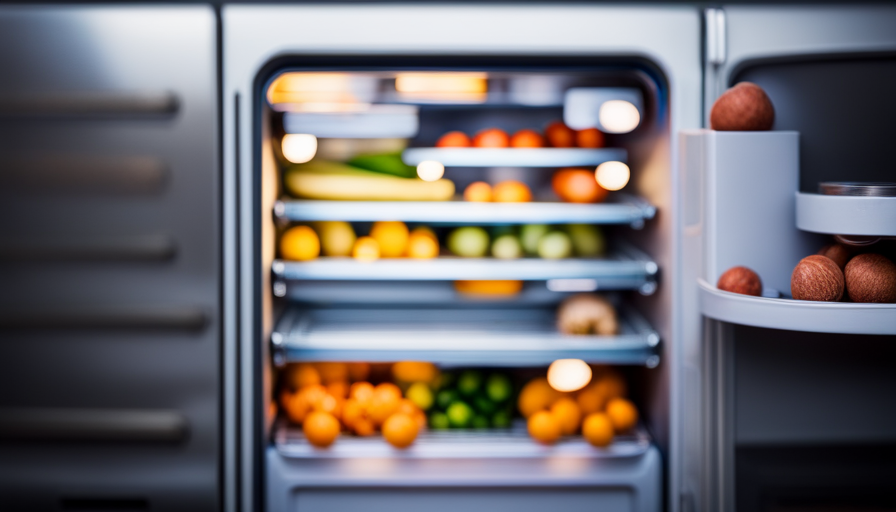Did you know that feeding your pet a raw food diet can provide numerous health benefits? According to a study conducted by the American Pet Products Association, 20% of pet owners in the United States have transitioned their pets from kibble to a raw diet.
If you’re considering making the switch, it’s important to know how much to feed your furry friend. Consulting with your veterinarian is the first step in determining the appropriate portion sizes based on your pet’s weight. Additionally, you’ll need to consider adjusting the portions for their age and activity level.
Transitioning from kibble to raw food requires a gradual process to avoid digestive upset. It’s also crucial to incorporate variety in your pet’s diet to ensure they receive all the necessary nutrients. Supplements and additional nutrients may be necessary to meet their dietary needs.
Finally, proper handling and storage of raw food is essential to prevent contamination. In this article, we will address these topics and provide answers to common concerns and FAQs surrounding the transition from kibble to raw food.
Key Takeaways
- Transitioning from kibble to raw food should be done gradually to avoid digestive upset.
- Portion sizes should be determined based on the pet’s weight, age, and activity level.
- Variety in a pet’s diet is important for ensuring they receive all necessary nutrients.
- Regular monitoring and follow-up appointments may be necessary to make adjustments to the diet.
Understanding the Benefits of a Raw Food Diet
Do you want your fur baby to experience the incredible benefits of a raw food diet? Understanding proper nutrition and transitioning slowly are key factors in making this change.
Raw food diets for pets have gained popularity in recent years, and for good reason. This type of diet mimics what animals would eat in the wild, providing them with a more natural and nutrient-rich meal.
Proper nutrition is essential for the overall health and well-being of our pets. Raw food diets offer a wide range of benefits for our furry friends. They provide a rich source of essential nutrients such as vitamins, minerals, and amino acids, which are vital for their growth and development. Raw food diets also contain enzymes that aid in digestion and support a healthy immune system.
Transitioning your pet to a raw food diet should be done gradually. Start by introducing small amounts of raw food alongside their regular kibble. Over time, increase the amount of raw food and decrease the kibble until they are fully transitioned. This gradual approach allows their digestive system to adapt to the new diet and prevents any potential digestive upset.
Understanding the benefits of a raw food diet and transitioning slowly are crucial steps in improving your pet’s overall health and well-being. By providing them with a diet that closely resembles what they would eat in the wild, you’re ensuring they receive the proper nutrition they need to thrive.
Consulting with Your Veterinarian
Consulting with your veterinarian is essential when transitioning your pet’s diet from kibble to a raw food diet as they can provide valuable guidance and advice. Here are some vet recommendations and a feeding schedule to help you navigate this process:
- Vet Recommendations:
- Schedule a check-up: Before making any dietary changes, it’s important to have your pet examined by a veterinarian. They’ll assess your pet’s overall health and identify any specific dietary needs or concerns.
- Gradual transition: Your vet may recommend gradually introducing raw food into your pet’s diet to allow for a smoother transition. This can help prevent any digestive upsets or discomfort.
- Balanced nutrition: Your veterinarian will provide guidance on ensuring your pet receives a balanced and complete diet. They’ll advise on the proper ratios of meat, bones, organs, and supplements to include in your pet’s meals.
- Regular monitoring: Your vet may suggest regular follow-up appointments to monitor your pet’s progress and make any necessary adjustments to their diet.
Feeding Schedule:
- Start with small portions: Begin by feeding your pet small, frequent meals of raw food. This helps their digestive system adjust gradually.
- Observe your pet’s response: Pay attention to any changes in your pet’s appetite, energy levels, and stool consistency. This’ll help you gauge if the feeding schedule is appropriate for your pet.
- Adjust portion sizes: Based on your vet’s recommendations and your pet’s individual needs, you may need to adjust the portion sizes to maintain a healthy weight.
Remember, your veterinarian is your best resource for guidance throughout this transition. They can provide personalized recommendations and ensure that your pet’s dietary needs are met.
Calculating Portion Sizes Based on Weight
When calculating portion sizes for your pet based on their weight, it’s important to consider their individual needs and consult with your veterinarian for personalized guidance. Did you know that a study found that overweight dogs have a higher risk of developing health issues such as arthritis and diabetes? By ensuring you feed your pet the appropriate portion sizes, you can help maintain a healthy weight and reduce the risk of these conditions.
To calculate the portion sizes for your pet, start by determining their ideal weight. This can be done by consulting with your veterinarian or using a body condition scoring system. Once you have the ideal weight, you can use a simple formula to calculate the daily portion size. Generally, it is recommended to feed 2-3% of your pet’s ideal weight per day. For example, if your dog’s ideal weight is 50 pounds, you would feed them 1-1.5 pounds of food daily.
However, it’s important to note that this is just a general guideline. Every pet is unique, and factors such as age, activity level, and metabolism should also be considered when calculating portion sizes. Additionally, it’s crucial to monitor your pet’s weight and adjust the portion sizes accordingly to ensure they are maintaining a healthy weight.
Proper weight management is essential for your pet’s overall health and well-being. By calculating portion sizes based on their weight and providing them with the appropriate amount of food, you can help prevent obesity and the associated health risks. Remember to consult with your veterinarian for personalized guidance and to monitor your pet’s weight regularly.
Adjusting Portions for Age and Activity Level
As your furry friend grows older and becomes more active, it’s crucial to adjust their portion sizes accordingly to ensure they maintain a healthy weight. When it comes to puppies, it is important to feed them more frequently and in smaller portions throughout the day.
Puppies have higher energy requirements and need more calories to support their growth and development. As a general guideline, they should be fed about 2-3% of their body weight per day, divided into multiple meals.
On the other hand, senior dogs may have a slower metabolism and lower activity levels, which means they require fewer calories to maintain a healthy weight. It is recommended to adjust their portion sizes to prevent weight gain and obesity. Senior dogs should be fed around 2% of their body weight per day, divided into two meals.
However, it is essential to monitor their weight and body condition regularly and make adjustments as needed.
It’s important to note that these are general guidelines, and individual dogs may have specific dietary needs. Consulting with your veterinarian is always recommended to determine the appropriate portion sizes for your dog based on their age, activity level, and overall health.
Transitioning from Kibble to Raw Food
Once you’ve decided to switch your dog’s diet, it’s important to gradually introduce the new nourishment, allowing their digestive system to adapt smoothly. The transitioning process from kibble to raw food can be challenging, but with the right approach, it can be a seamless experience.
Start by slowly incorporating small amounts of raw food into your dog’s regular meals. Begin with a ratio of 75% kibble and 25% raw food, and gradually increase the proportion of raw food over a period of two to three weeks. This gradual transition will minimize any potential digestive upsets and allow your dog’s body to adjust to the new diet.
During the transitioning process, it’s crucial to monitor your dog’s stool consistency and overall well-being. Some common challenges that may arise include loose stools or an upset stomach. If these issues occur, you may need to slow down the transition process or consult with a veterinarian for guidance.
Remember, each dog is unique, and the transitioning process may vary. It’s essential to observe your dog’s individual response and adjust accordingly. With patience and consistency, you can successfully transition your dog from kibble to raw food, providing them with a nourishing and balanced diet.
Monitoring Your Pet’s Weight and Health
To ensure your pet stays healthy, it’s important to regularly monitor their weight and overall well-being. Here are four key items to consider when monitoring your pet’s weight and health:
-
Establish a baseline: Before transitioning your pet from kibble to raw food, it’s essential to establish a baseline weight. This will help you track any changes in their weight over time and ensure they’re maintaining a healthy weight.
-
Track weight trends: Once you’ve established a baseline weight, continue to monitor your pet’s weight regularly. Weigh them at least once a month to track any weight fluctuations. Sudden weight gain or loss could indicate an underlying health issue that needs attention.
-
Adjust portions: As you transition your pet to a raw food diet, it’s crucial to adjust their portion sizes accordingly. Raw food generally has a higher moisture content, so you may need to increase the amount you feed your pet to ensure they’re getting enough nutrition.
-
Consider exercise routine: Alongside monitoring their weight, it’s important to evaluate your pet’s exercise routine. Regular exercise is crucial for maintaining a healthy weight and overall well-being. Ensure your pet gets enough physical activity based on their age, breed, and energy levels.
By closely monitoring your pet’s weight trends and considering their exercise routine, you can ensure they stay healthy and thrive on a raw food diet.
Incorporating Variety in Your Pet’s Diet
Now that you’ve got a good understanding of how to monitor your pet’s weight and health, let’s talk about incorporating variety in their diet.
Variety is important because it ensures that your pet is getting a wide range of nutrients and helps prevent boredom with their meals.
When it comes to variety options, there are several things you can do. First, consider rotating different protein sources such as chicken, beef, and fish. Each protein source has its own unique set of nutrients, so by rotating them, you can ensure your pet is getting a balanced diet.
Additionally, you can include different fruits and vegetables in your pet’s meals to provide them with additional vitamins and minerals.
Meal planning is also an important aspect of incorporating variety. It’s a good idea to plan your pet’s meals in advance to ensure they are getting a balanced diet over time. You can create a meal plan that includes different protein sources and rotates them throughout the week. This way, you can easily keep track of what your pet is eating and make sure they’re getting the variety they need.
By incorporating variety in your pet’s diet and planning their meals, you can ensure they’re getting all the nutrients they need for optimal health.
Introducing Supplements and Additional Nutrients
Introducing supplements and additional nutrients can greatly enhance your pet’s overall well-being and leave them feeling vibrant and full of life! When transitioning your pet from kibble to a raw food diet, it’s important to ensure they are getting all the necessary nutrients. While raw food provides a wide range of essential nutrients, some supplements may be needed to meet specific dietary requirements.
Supplement dosages should be carefully calculated based on your pet’s weight, age, and health condition. It’s best to consult with a veterinarian or a pet nutritionist to determine the appropriate dosage for your furry friend. Additionally, keep in mind that some nutrients are better absorbed when paired with others. For example, Vitamin D is better absorbed when taken with calcium.
To help you better understand the importance of supplements and additional nutrients, here is a table outlining some key nutrients and their benefits:
| Nutrient | Benefits | Dosage (per day) |
|---|---|---|
| Omega-3 fatty acids | Promotes healthy skin and coat | 1000mg – 1500mg |
| Probiotics | Supports digestive health | Varies depending on the strain |
| Vitamin E | Antioxidant properties | 5-10 IU per pound of body weight |
| Calcium | Promotes strong bones and teeth | 20-30mg per pound of body weight |
Remember, incorporating supplements and additional nutrients into your pet’s diet can have a positive impact on their overall health. However, always consult with a professional to ensure you are providing the right dosage and combination for your pet’s specific needs.
Ensuring Safe Handling and Storage of Raw Food
Make sure you handle and store your pet’s new diet of fresh, wholesome meals like a pro chef, keeping it as safe and secure as a treasured family recipe. When it comes to raw food, safe handling and storage are crucial to prevent the growth of harmful bacteria and ensure the health of your furry friend.
Follow these storage precautions to maintain the integrity of the food and minimize the risk of contamination.
Firstly, always handle raw food with clean hands and separate utensils to prevent cross-contamination. Wash your hands thoroughly before and after handling the food, and use separate cutting boards and knives for raw meat and other ingredients. This will help avoid the transfer of bacteria from the raw food to other surfaces.
Secondly, store raw food in appropriate containers and refrigerate or freeze it promptly. Keep raw food separate from other foods to prevent any potential contamination. Make sure the containers are tightly sealed to prevent any leaks or spills that could contaminate other items in the fridge or freezer.
Lastly, regularly clean and sanitize the storage areas to maintain a hygienic environment. This includes cleaning the fridge or freezer regularly, wiping down shelves and drawers, and disposing of any expired or spoiled raw food.
By following these safe handling and storage precautions, you can ensure that your pet’s raw food remains fresh, wholesome, and free from harmful bacteria.
Addressing Common Concerns and FAQs
If you’ve been considering switching your pet’s diet, you might have some common concerns and questions that need addressing. One of the most common concerns is about how much to feed when transitioning from kibble to raw food. It’s important to note that the feeding guidelines for raw food may be different from those for kibble.
When it comes to feeding guidelines for raw food, it’s recommended to feed your pet approximately 2-3% of their body weight per day. This can vary depending on factors such as age, activity level, and metabolism. It’s crucial to monitor your pet’s weight and adjust the portion size accordingly to maintain a healthy weight.
Another concern is whether raw food provides all the necessary nutrients for your pet’s well-being. Raw food diets can be nutritionally balanced if they include a variety of meat, bones, organs, and some fruits and vegetables. However, it’s essential to consult with a veterinarian or a veterinary nutritionist to ensure that your pet’s diet meets their specific nutritional needs.
Lastly, some pet owners worry about the safety of feeding raw food due to the potential risk of bacteria. It’s important to handle raw food with proper hygiene practices, including washing hands and utensils thoroughly after handling. Additionally, freezing the raw food before feeding can help reduce the risk of bacterial contamination.
By addressing these common concerns and following the appropriate feeding guidelines, you can safely transition your pet to a raw food diet and provide them with a nutritionally balanced meal.
Frequently Asked Questions
Can I mix kibble and raw food together in my pet’s diet?
Yes, you can mix kibble and raw food together in your pet’s diet. There are benefits and drawbacks to a mixed diet. The benefits include a variety of nutrients from both sources, improved digestion, and potential dental benefits from chewing on raw food. However, there are drawbacks, such as the risk of bacterial contamination from raw food and the potential for imbalances in the diet. It’s important to consult with your veterinarian to ensure a balanced and safe mixed diet for your pet.
How do I know if my pet is getting all the necessary nutrients on a raw food diet?
To ensure nutrient balance on a raw food diet, monitor your pet’s weight and coat health. Keep an eye out for any signs of deficiencies, such as dull fur or weight loss.
Address specific health concerns by consulting with a veterinarian or a veterinary nutritionist. They can provide guidance on adding supplements or adjusting the diet to meet your pet’s individual needs.
Regular check-ups and blood tests can also help assess overall nutrient status.
Are there any specific guidelines for feeding raw food to puppies or kittens?
When feeding puppies or kittens a raw food diet, there are specific guidelines to ensure their nutritional needs are met.
For puppies, it’s recommended to feed them 2-3% of their body weight per day, divided into multiple meals. This should consist of a balance of muscle meat, organ meat, and bones.
Kittens, on the other hand, require a higher protein intake, with 5-8% of their body weight per day being the general recommendation.
It’s important to consult with a veterinarian to develop a specific plan for your pet.
Can I feed my pet raw meat from the grocery store?
Yes, you can feed your pet raw meat from the grocery store as part of a raw food diet. However, it’s important to ensure that the meat is fresh, of high quality, and suitable for your pet’s consumption. Feeding raw meat can provide various benefits such as improved digestion, healthier skin and coat, and increased energy levels. Consult with a veterinarian or a pet nutritionist to make sure your pet’s raw food diet is balanced and meets their nutritional needs.
What should I do if my pet experiences digestive issues after transitioning to a raw food diet?
If your pet experiences digestive issues after transitioning to a raw food diet, there are several steps you can take to address the problem.
First, consider introducing the raw food gradually, allowing their digestive system to adjust.
Monitor their stool consistency and frequency, as well as any signs of discomfort or vomiting.
If issues persist, consult with a veterinarian to rule out underlying health conditions and ensure a smooth transition to raw food.
How Does Dehydrated Food Comparatively Affect Portion Sizes When Switching from Kibble to Raw Food?
When switching from kibble to raw bistro dehydrated food yield, the portion sizes may differ. Dehydrated food tends to have a higher yield, as the moisture is removed, making the food more concentrated. It’s important to carefully measure and adjust portion sizes to ensure your pet receives the right amount of nutrition.
Conclusion
In conclusion, transitioning your pet from kibble to a raw food diet requires careful consideration and guidance from your veterinarian.
Just like embarking on a new adventure, you need to calculate portion sizes based on your pet’s weight, adjust them according to their age and activity level, and introduce variety to keep things exciting.
Remember to incorporate supplements and ensure safe handling and storage of raw food.
By following these steps, you’ll embark on a journey that will nourish your pet’s health and well-being. Bon appétit!

